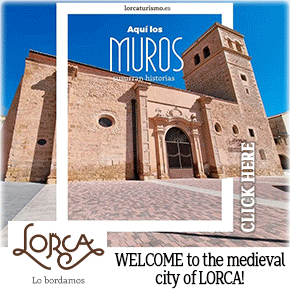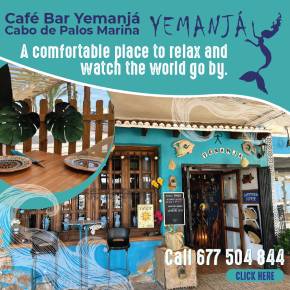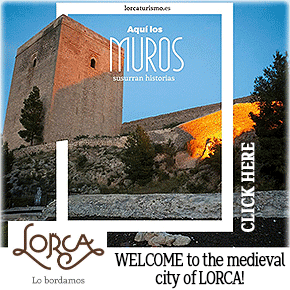October 11 to 15 International Potholing and Caving Camp in Caravaca de la Cruz
300 caving enthusiasts gather in Caravaca to explore underground cavities in Murcia
 Over 300 potholers and caving enthusiasts will be descending on – and quite literally into – the municipality of Caravaca de la Cruz in the north-west of the Region of Murcia between October 11 and 15 for the International Speleology Camp, during which they will explore some of the 150 or so caves and potholes of which can be entered in the Region.
Over 300 potholers and caving enthusiasts will be descending on – and quite literally into – the municipality of Caravaca de la Cruz in the north-west of the Region of Murcia between October 11 and 15 for the International Speleology Camp, during which they will explore some of the 150 or so caves and potholes of which can be entered in the Region.
Among the most interesting caves in Murcia are the Cueva de la Barquilla, Cueva Negra and the Cueva del Rey Moro, and as well as visiting these sites the participants in the camp will also be able to attend a series of workshops and conferences. One of these is being presented by elite sportswoman Beatriz Flamini, who recently set a new world record by remaining in isolation in an underground cave for 500 days.
Also included are beginners’ days for those who are interested in learning about potholing and a concert by Ellos Rock Band.
In a sense Caravaca can be considered the home of caving in the Region of Murcia due to the early documented explorations made in the early 19th century by D.J. Cisneros in the Cueva de la Barquilla, which were published by the Natural History Society of Madrid. Cisneros was the first to explore the cave and the Barquilla was the first cave in Murcia to be documented.
Many years later, around 1950, the “G.I.E. de Caravaca” group was formed, the pioneering group in caving in Murcia, and published articles about various sites in the Region, while in 1991 the Asociación Deportiva ADENOW began to spread the word about all nature-related active tourism, including hiking, mountaineering, climbing, skiing and caving.
Further information about the camp can be found online here.
Oficina de Turismo de Caravaca de la Cruz
 More information about the places of interest which can be visited in the municipality of Caravaca de la Cruz, along with what's on and local news can be found in the Caravaca Today.
More information about the places of interest which can be visited in the municipality of Caravaca de la Cruz, along with what's on and local news can be found in the Caravaca Today.
Caravaca de la Cruz, in the north-west of the Region of Murcia, is one of only 5 Holy Cities in the Roman Catholic world, a centre of pilgrimage, along with Rome, Jerusalem, Santiago de Compostela and Santo Toribio de Liebana, and is home to the Cross of Caravaca, the Vera Cruz.
The status of Holy City was bestowed by Pope John Paul II in 1998, granting the City a Permanent Jubilee year every 7 years for perpetuity, the first one held in 2003 and the next in 2024.

The strategic and natural advantages of Caravaca de la Cruz have attracted the attention of settlers for more than 800,000 years, the Cueva Negra yielding remains of Homo Heidelbergensis, forbears of the Neanderthals and the municipality also houses important archaeological remains from the Argaric, Iberian and Roman cultures. many of these can be seen in the Municipal Archaeological Museum.
 As a border town caught between the Catholic forces of Castille and the last remaining Moorish stronghold in Spain, Granada, Caravaca had a turbulent medieval history, but it was during this period that the legend of the Cross of Caravaca was born, bringing the religious orders which shaped the structure of Caravaca today, with its impressive hilltop castle and eclectic collection of churches and monasteries, religious tourism today being a backbone of the town´s economy.
As a border town caught between the Catholic forces of Castille and the last remaining Moorish stronghold in Spain, Granada, Caravaca had a turbulent medieval history, but it was during this period that the legend of the Cross of Caravaca was born, bringing the religious orders which shaped the structure of Caravaca today, with its impressive hilltop castle and eclectic collection of churches and monasteries, religious tourism today being a backbone of the town´s economy.
Caravaca de la Cruz is a municipality with important natural resources, including extensive forests, part of which have protected status due to their wealth of flora and fauna, and due to the abundant water supplies is also a major area for canned fruit production, apricots in particular being an important crop.
 Caravaca is renown for its important May Fiestas, held in honour of the Vera Cruz, which also incorporate the Moors and Christians celebrations and the Running of the Wine Horses.
Caravaca is renown for its important May Fiestas, held in honour of the Vera Cruz, which also incorporate the Moors and Christians celebrations and the Running of the Wine Horses.
Caravaca de la Cruz is also the home of Europe´s largest collection of ethnic instruments at Barranda, the Museo de Música Étnica Barranda and is the location of the Barranda festival de Cuadrillas, which celebrates the Region's ethnic music traditions.
The municipality is home to around 26,000 inhabitants and shares boundaries with Moratalla, Cehegín, Lorca, Puebla de Don Fadrique in the province of Granada and Vélez-Blanco in the province of Almería.
Opening times:
Weekdays: 10.00 to 14.00 and 16.30 to 19.30
Saturdays: 10.30 to 14.00 and 16.30 to 19.30
Sundays and public holidays: 10.30 to 14.00
Click for map, Caravaca de la Cruz Tourist Office

































